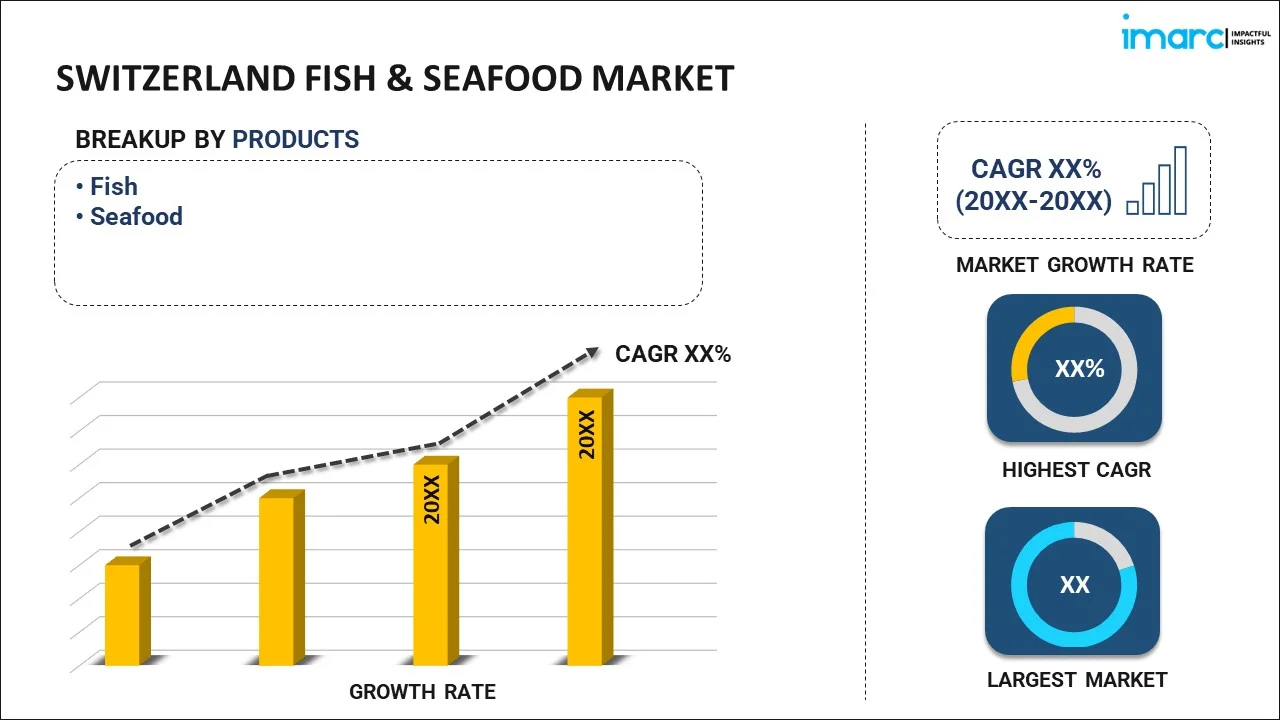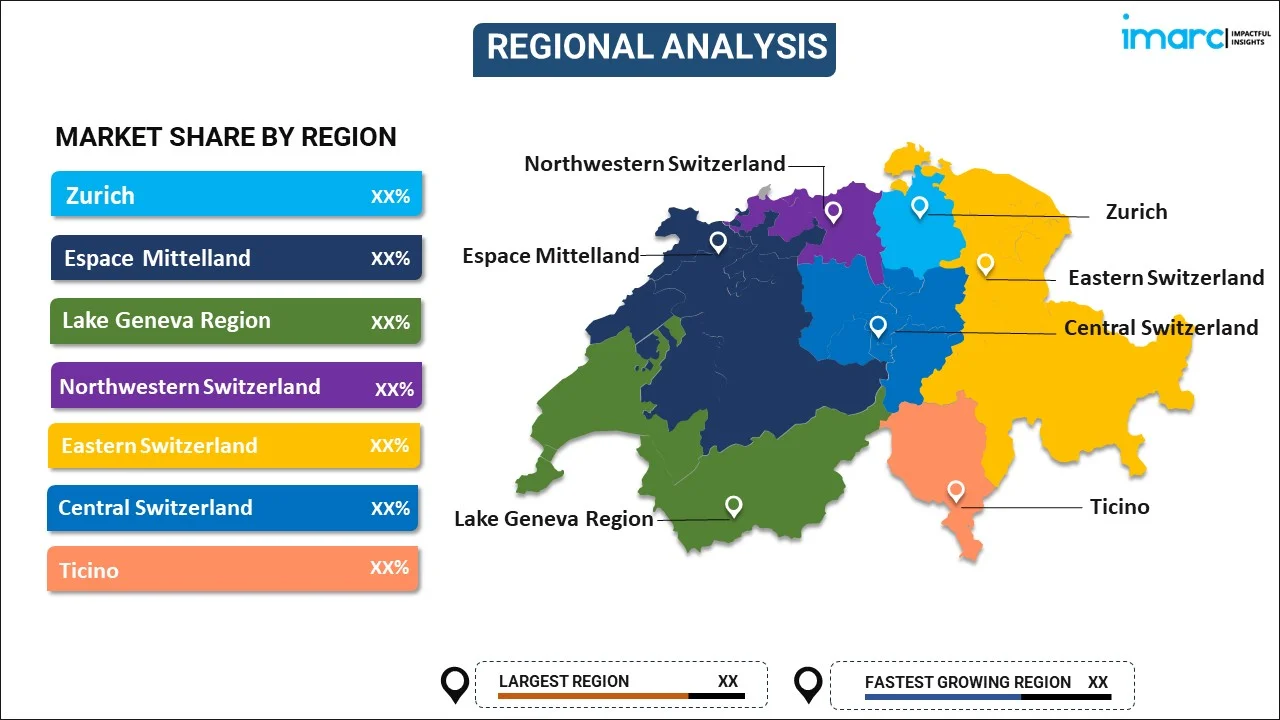
Switzerland Fish & Seafood Market Report by Product (Fish, Seafood), Form (Fresh, Frozen, Canned, Cured), Distribution Channel (Offline, Online), and Region 2025-2033
Switzerland Fish & Seafood Market Overview:
The Switzerland fish & seafood market is projected to exhibit a growth rate (CAGR) of 4.50% during 2025-2033. The growth of the market is being favored by a shifting consumer preference for healthy and sustainable diets, advancements in aquaculture technology, and rising sustainable fishing practices to ensure a stable supply and variety. The market is further driven by the rising awareness among individuals regarding the benefits of seafood consumption and improved distribution channel across the country.
|
Report Attribute
|
Key Statistics
|
|---|---|
|
Base Year
|
2024 |
|
Forecast Years
|
2025-2033
|
|
Historical Years
|
2019-2024
|
| Market Growth Rate (2025-2033) | 4.50% |
Switzerland Fish & Seafood Market Trends:
Increasing Consumer Preference for Protein-Rich Diets
Increasing consumer preference for protein-rich diets serves as a key driver for Switzerland's fish and seafood market growth, reflecting a broader shift toward healthier eating habits. According to a research article published in National Library of Science, in the European region, fish and seafood consumption has risen over the past 10 years up to the current 24.3 kg per capita per year. As consumers become more health-conscious, they incline toward food that offer substantial nutritional benefits, including fish and seafood primarily known for their high protein content, omega-3 fatty acids, and essential vitamins. This, in turn, has surged the import and distribution of diverse seafood products. According to the Federal Office for Agriculture, the average Swiss person consumes nine kilos of seafood annually. A 2021 review of the Swiss fish market by researchers from the University of Bern found that 96% of all fish consumed in Switzerland is imported. Moreover, as per other reports, Switzerland's import demand for seafood products is expected to rise by 4.6% in 2024, with a growing trend towards organic products. In the first nine months of 2023, trade between Vietnam and Switzerland increased modestly by 2%, reaching over 1.85 billion USD.
Advancements in Sustainable Aquaculture and Fishing Practices
Advancements in sustainable aquaculture and fishing practices are crucial drivers for Switzerland fish and seafood market growth. These practices guarantee a dependable, high-quality supply of seafood, catering to the increasing demand from environmentally conscious consumers. According to a report, around 96% of all fish consumed in Switzerland is imported but it is estimated that only 40% can be considered sustainable. By minimizing the environmental impact of fishing and farming, sustainable methods align with the growing preference for eco-friendly and ethically sourced products. According to a new report from the nonprofit group Good Food Institute (GFI), investments in alternative seafood products nearly doubled in 2021 compared to the previous year. A total of $175 million (€162 million) was invested in companies producing or planning to produce seafood from plant materials, grown from cells, or produced through fermentation processes. This represents a 92% increase from the $91 million (€84.3 million) invested in the sector in 2020. For instance, researchers at ETH Zurich, Lukas Bocker and Severin Eder, are developing shrimp from microalgae. Their goal is to replicate the taste and nutritional value of real shrimp by combining a specific type of microalgae with other plant-based protein sources such as soy and pea meal. Currently, the researchers are aiming to have a market-ready product by the end of the year.
Switzerland Fish & Seafood Market News:
- In September 2023, Swiss Blue Salmon (SBS) announced its selection of Norway-based VAQ to design the recirculating aquaculture system (RAS) for a 3,400 metric ton facility that SBS plans to construct in Mollis, Switzerland.
- In August 2023, Swiss Blue Salmon AG launched its sustainable production of premium-quality farmed salmon is the Swiss Alps. Their new state-of-the-art facility will be vertically integrated from hatchery and grow-out to processing, ensuring the highest standards of animal welfare, bio-security, and product quality. This sustainable local production model aims to provide the freshest and healthiest salmon on the market, grown near consumers in an environmentally friendly manner that protects the ecosystem and reduces the carbon footprint.
Switzerland Fish & Seafood Market Segmentation:
IMARC Group provides an analysis of the key trends in each segment of the market, along with forecasts at the country level for 2025-2033. Our report has categorized the market based on product, form, and distribution channel.
Product Insights:

- Fish
- Seafood
The report has provided a detailed breakup and analysis of the market based on the product. This includes fish and seafood.
Form Insights:
- Fresh
- Frozen
- Canned
- Cured
A detailed breakup and analysis of the market based on the form have also been provided in the report. This includes fresh, frozen, canned, and cured.
Distribution Channel Insights:
- Offline
- Online
The report has provided a detailed breakup and analysis of the market based on the distribution channel. This includes offline and online.
Regional Insights:

- Zurich
- Espace Mittelland
- Lake Geneva Region
- Northwestern Switzerland
- Eastern Switzerland
- Central Switzerland
- Ticino
The report has also provided a comprehensive analysis of all the major regional markets, which include Zurich, Espace Mittelland, Lake Geneva Region, Northwestern Switzerland, Eastern Switzerland, Central Switzerland, and Ticino.
Competitive Landscape:
The market research report has also provided a comprehensive analysis of the competitive landscape. Competitive analysis such as market structure, key player positioning, top winning strategies, competitive dashboard, and company evaluation quadrant has been covered in the report. Also, detailed profiles of all major companies have been provided.
Switzerland Fish & Seafood Market Report Coverage:
| Report Features | Details |
|---|---|
| Base Year of the Analysis | 2024 |
| Historical Period | 2019-2024 |
| Forecast Period | 2025-2033 |
| Units | US$ Billion |
| Scope of the Report | Exploration of Historical Trends and Market Outlook, Industry Catalysts and Challenges, Segment-Wise Historical and Future Market Assessment:
|
| Products Covered | Fish, Seafood |
| Forms Covered | Fresh, Frozen, Canned, Cured |
| Distribution Channels Covered | Offline, Online |
| Regions Covered | Zurich, Espace Mittelland, Lake Geneva Region, Northwestern Switzerland, Eastern Switzerland, Central Switzerland, Ticino |
| Customization Scope | 10% Free Customization |
| Post-Sale Analyst Support | 10-12 Weeks |
| Delivery Format | PDF and Excel through Email (We can also provide the editable version of the report in PPT/Word format on special request) |
Key Questions Answered in This Report:
- How has the Switzerland fish & seafood market performed so far and how will it perform in the coming years?
- What has been the impact of COVID-19 on the Switzerland fish & seafood market?
- What is the breakup of the Switzerland fish & seafood market on the basis of product?
- What is the breakup of the Switzerland fish & seafood market on the basis of form?
- What is the breakup of the Switzerland fish & seafood market on the basis of distribution channel?
- What are the various stages in the value chain of the Switzerland fish & seafood market?
- What are the key driving factors and challenges in the Switzerland fish & seafood?
- What is the structure of the Switzerland fish & seafood market and who are the key players?
- What is the degree of competition in the Switzerland fish & seafood market?
Key Benefits for Stakeholders:
- IMARC’s industry report offers a comprehensive quantitative analysis of various market segments, historical and current market trends, market forecasts, and dynamics of the Switzerland fish & seafood market from 2019-2033.
- The research report provides the latest information on the market drivers, challenges, and opportunities in the Switzerland fish & seafood market.
- Porter's five forces analysis assist stakeholders in assessing the impact of new entrants, competitive rivalry, supplier power, buyer power, and the threat of substitution. It helps stakeholders to analyze the level of competition within the Switzerland fish & seafood industry and its attractiveness.
- Competitive landscape allows stakeholders to understand their competitive environment and provides an insight into the current positions of key players in the market.
Need more help?
- Speak to our experienced analysts for insights on the current market scenarios.
- Include additional segments and countries to customize the report as per your requirement.
- Gain an unparalleled competitive advantage in your domain by understanding how to utilize the report and positively impacting your operations and revenue.
- For further assistance, please connect with our analysts.
 Inquire Before Buying
Inquire Before Buying
 Speak to an Analyst
Speak to an Analyst
 Request Brochure
Request Brochure
 Request Customization
Request Customization




.webp)




.webp)












